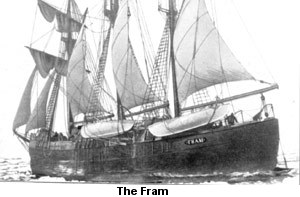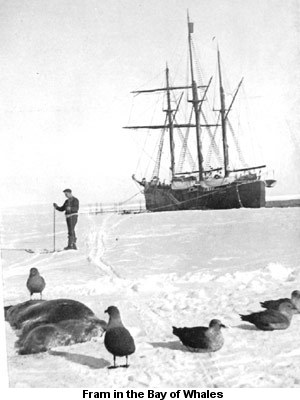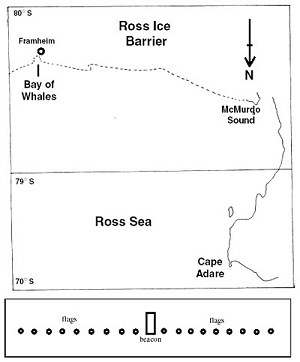
| Glasgow Digital Library | Voyage of the Scotia | BRUCE | PEOPLE | SHIP | ANTARCTIC | INDEX |
|---|

Fram was fitted with a Bolinder diesel engine, the first such ship to head into southern waters. Engine trouble on the round-Britain survey resulted in an engineer being sent from the Laxevaag works in Sweden. The fitter who helped build the engine not only repaired it but also signed on as a engineer for the Fram cruise.
Fram sailed on 7 June 1910 (Scott's ship sailed on 15 June), fully equipped for an attempt on the South Pole. A total of 110 sledge dogs, 10 sledges, 20 pairs of skis, 40 ski poles plus reindeer sleeping bags and scientific equipment - as suggested by Nansen - were aboard. When Fram reached Madeira the crew were informed - for the first time - that they were heading for the Antarctic. The press was informed and a telegram sent to Scott in Melbourne stating that Amundsen was heading for the South Pole. The race was on! Amundsen was the only man aboard Fram who had been to the Antarctic before.
Diesel engines
Rudolph Diesel was a German who worked for the Sulzer engine manufacturer in Switzerland. In 1892 he patented a new type of engine - a diesel. The first successful engine was built in 1895 and eight firms were licensed to build the new engine, including Nobel in Sweden, Krupps in Germany and Sulzer in Switzerland. There were very few diesel engines in boats until 1908 due to their weight, so Fram was unusual. The first ocean-going merchant ship to be fitted with a diesel engine was Selandia, built in Copenhagen in 1912.

On 1 January 1911 the first ice was spotted and Fram entered the pack ice. On 14 January the ship was tied up to the ice barrier in the Bay of Whales (which had been named by Shackleton). Fram was to remain at the new Antarctic base - called Framheim - until 15 February. The crew were unloading stores and helped set up the base. Before Fram left, she reached 78°41'S, the furthest south any ship had been. Fram also held the record for the furthest north when Nansen took her to 83°59'N. Fram was to go to Buenos Aires for repairs then do oceanographic work between Buenos Aires and Cape Town - a task suggested by Bruce in his plans for a second Antarctic expedition.
The Bay of Whales was an indentation in the ice barrier and quite sheltered. The base at Framheim consisted of a large wooden hut, along with tents for stores and for the dogs (which numbered 116). When Fram left, nine men were in the base at Framheim. Their main task was establishing the base and making a start at the supply dumps before the winter set in. The dumps were for those who were to attempt the South Pole next spring.
While in Framheim unloading, they had a visit from Scott's ship Terra Nova. While Scott was at the South Pole, the Terra Nova had been exploring the Ross Sea area.

The first depot was set up at 80°S. Each depot had a beacon (made of blocks of snow) and a line of flag poles, each with a numbered flag. On the return journey the expedition party would only have to find one flag to find the depot. The first depot at 80°S was reached on 27 February 1911 and the depot at 81°S on 3 March. The temperature was -49°F. They reached the site for the 82°S depot, set up the supply base and then had to return to Framheim because of the exceptionally cold weather.
Eight dogs died on this trip. On 31 March a last journey was made to the depot at 80°S, and as the grip of winter confined the expedition to their base over three tons of supplies had been taken to the bases on sledges.
The Antarctic winter was spent in Framheim working on provisions, clothing, sledges and new tents. Tunnels were built into the ice barrier for workshops and even a sauna was built underground. Over 60 tons of seals had been killed before the winter to provide food for the dogs - and for the men. Fram had a library of 3,000 books.
The first journey south after the winter left on 8 September, but by 11 September the temperature had dropped to -67.9°F and they returned to base leaving more stores at 80°S.
| Glasgow Digital Library | Voyage of the Scotia | BRUCE | PEOPLE | SHIP | ANTARCTIC | INDEX |
|---|